Neil Gaiman's Sandman
Does this page look funny?The Books
Picture Credits
 Neil Gaiman may be the Shakespeare of comics. Not that he's as good as Shakespeare, necessarily, but he may end up having a similar kind of impact. Before Shakespeare, plays were not really considered literature. They were regarded by the literary establishment of the time about the same way today's academics regard, say, television sitcoms. Or comic books.
Neil Gaiman may be the Shakespeare of comics. Not that he's as good as Shakespeare, necessarily, but he may end up having a similar kind of impact. Before Shakespeare, plays were not really considered literature. They were regarded by the literary establishment of the time about the same way today's academics regard, say, television sitcoms. Or comic books.
During his life, William Shakespeare's reputation as a poet lay primarily on his sonnets, which today are considered pretty good but not as great as his plays. It was only after he died that his very popular plays began being taken seriously as literature. It is largely because of Shakespeare that dramatists are accorded high honors in the field of letters. Ironically, Ben Jonson, who was thought of as a superior poet during Shakespeare's day, is now primarily remembered as one of the "other playwrights" of the English Renaissance.
Gaiman has gotten more attention from the mainstream press than anybody but Art Spiegelman, and while articles about MAUS tend to treat it as a unique object, articles about Gaiman usually mention other "new voices" in comics, and point out that his major work, SANDMAN, is by no means his only contribution to the field. Some might argue that Gaiman is undeserving of such attention, that this or that favorite writer, artist or writer/artist should be hailed as the greatest, should be getting the attention. One of my English teachers thought Christopher Marlowe was twice the writer Shakespeare was, but whose name is synonymous with literary greatness?
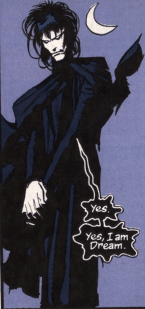 In any case, the important thing is that Marlowe's plays still live today - and modern playwrights like Arthur Miller are taken seriously as literary artists - because Shakespeare lifted up the whole medium through his reputation. Arguments about whether the reputation was deserved are almost pointless.
In any case, the important thing is that Marlowe's plays still live today - and modern playwrights like Arthur Miller are taken seriously as literary artists - because Shakespeare lifted up the whole medium through his reputation. Arguments about whether the reputation was deserved are almost pointless.
In my opinion, though, my literature teacher was wrong. Sure, there are a couple of masterpieces among Marlowe's handful of plays. Perhaps if he hadn't been killed he would have been what Shakespeare was. But the breadth and depth of Shakespeare's life's work is astonishing. And it's also remarkable how few clunkers there are among his three dozen or so plays (scholars argue the exact number).
Gaiman exhibits the same kind of sure-handedness. Everything he puts his hand to seems to come out, at the very least, interesting and enjoyable. Below there are a few times when I disparage this or that individual story as being "weaker" than the rest. Be sure to keep in mind the context that the very worst Gaiman story (and nothing in SANDMAN represents Gaiman at his worst) still rises head and shoulders above almost all the work in his field. No, dammit, it's more than that: the worst Gaiman still rises above most published short stories, most best selling novels, most movies. He can write anything. He has written journalistic articles, television screenplays, short stories and novels, but his medium of choice is comics.
As a comics creator, Gaiman has produced several gems. With Dave McKean, he has done three "graphic novels," two of them at least semi-autobiographical. Violent Cases, Signal to Noise and Mr. Punch are all listed on my page of Recommended Comic Books, along with The Books of Magic and Black Orchid. But SANDMAN is something special.
NOTE: Since this page was originally written, Neil has produced Neverwhere and Stardust. The former was first a BBC TV series, then a novel, and may soon be a film. The latter was originally done as a lavishly illustrated novel originally published in four parts by DC comics, then also a text-only rewritten and expanded version. My review of the latter is on my reviews page, and in conjunction with the book tour promoting it I also got to interview Neil, which was a delightful experience.
Erudite, allusive, complex and ambitious, SANDMAN is undoubtedly the finest writing the mainstream comic book industry has ever seen. It dares to tell the story of Morpheus, also known as Dream, the Prince of Stories, one of the seven Endless who are not gods, because gods die when men stop believeing in them. The Endless are older and larger than gods. Creating his own mythology, Gaiman incorporates all past mythology into his own - some specifically and explicitly, the rest by implication.
It is, perhaps, appropriate - an audacious and deliberate statement by Gaiman? - that Shakespeare himself is an important character in the series. Though he shows up only three times (and the first time only for one brief scene), his deal with Dream (see "Men of Good Fortune" below) resonates throughout the storyline, and he is given the place of honor, starring in the very last comic of the original series, the last chapter of the complete work.
As might be expected for such a high-profile piece (although unusual for a monthly comic that ceased publishing over a year ago) there are many, many SANDMAN home pages. One of the best is The Wake, which includes a list of the various books and which issues they reprinted, and links to several other pages. Dylan Verheul, who maintains that site, is also now the official keeper of the SANDMAN Annotations, which goes page by page and even panel by panel keeping track of the characters and explaining allusions (and Gaiman is a most allusive writer). However, The Wake is putting up the annotations gradually, so for now I'm keeping a link to the original list (complete through issue #71). Another good SANDMAN site is The Dreaming, while fans of Neil Gaiman in general might want to keep up with The Magian Line, an online version of his fan club newsletter.
Listed below are the "graphic novels" that the 76 issues (1-75 plus one special) have been collected into, plus a few related books. In my view these books can't really be thought of as graphic novels (see my rant on the subject to see why), but taken as a whole the series itself is a multi-volume graphic novel smaller but similar to what Dave Sim is doing with Cerebus. I have written descriptions of varying lengths for the books, plus each book has a link to amazon.com if you'd like to order it from them.
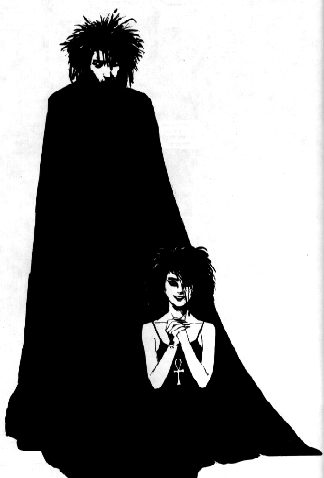 Which book should you start with? It depends on your taste, and what you're after. If you've read any of the comics, or seen several websites like this one, and are already convinced you want to read the whole thing, then you might as well start with the beginning. The entire series is, in fact, one story, and should be read that way.
Which book should you start with? It depends on your taste, and what you're after. If you've read any of the comics, or seen several websites like this one, and are already convinced you want to read the whole thing, then you might as well start with the beginning. The entire series is, in fact, one story, and should be read that way.
But if you want to read a little bit first, to see if you're going to like it before you make a commitment to invest a considerable amount of money (and the ten trade paperbacks add up to a hefty sum), I would not suggest buying the first one first. For the first few issues SANDMAN thought of itself as primarily a horror magazine, and Gaiman himself has said he didn't really find his voice for the series until #8.
The shocking, terrible, truly horrific "24 Hours" made my skin crawl, and if I had read it first, or even in sequence in the first book, it's possible I would have abandoned the whole thing. It's true that gruesome horror would occasionally occur again in the series, and it's also true that that kind of horror has its place. I'll even admit that, on rereading the entire series, "24 Hours" is both a remarkable literary achievement and absolutely necessary to the overall storyline. It is still not the best place for a new reader to be introduced to the SANDMAN, except for fans of Stephen King and Clive Barker.
Some people have said that the short stories are the better than the longer stories, and as most of them are reasonably self-contained the short story collections make good places to sample SANDMAN and see if it's for you. That's probably true, but I would recommend starting with The Doll's House. Perhaps it's because that was my introduction to the series. The first trade paperback collected, it starts with the wonderful "The Sound of Her Wings," originally published as SANDMAN #8 (puzzlingly, this is also the last story in the first collection). In this story, Gaiman says he found his voice as he introduced Dream's older sister, Death, who quickly became so popular she was given two spin-offs of her own.
Dream Country, the first book of short stories, contains the wonderful "Midsummer Night's Dream," with art by Charles Vess, that won the World Fantasy Award for Best Short Story, so if you do want to start with short stories that's probably the book to choose.
If you like SANDMAN, though, you'll eventually have to buy them all and start over with the beginning, because it really is all one story.
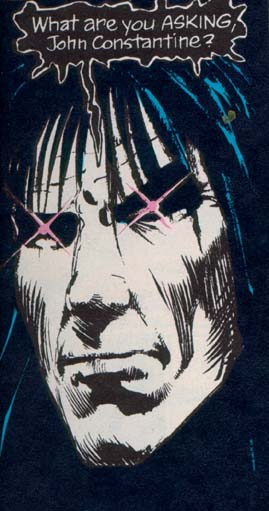
There's some controversy among SANDMAN fans whether you should start with this book or not. Obviously, since the entire series is essentially one long multi-volume graphic novel, it makes sense to start at the beginning. Certainly, if you fall in love with the story you will have to read this eventually, and read or reread everything else in sequence. But Gaiman was still feeling his way when he wrote these stories, and the original aim of the title seemed to be to present horror stories. Gaiman would return to the kind of unflinching awfulness he presents here a few times later in the series, but this collection is almost unrelenting. If I'd read it first, I might never have read anything else. But I read it after I'd already read The Doll's House, so I knew where he was going and trusted him. Still, it's rough going, and if you're at all squeamish about the kind of unflinching horror written by Stephen King and Clive Barker, this is not the best place to start.
 Order The Sandman Vol. 1: Preludes and Nocturnes from amazon.com
Order The Sandman Vol. 1: Preludes and Nocturnes from amazon.com
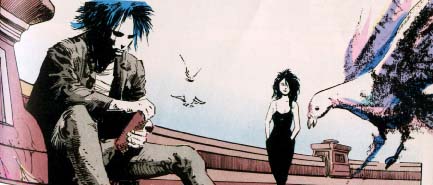
When it was first printed, "The Doll's House" opened with what is now the last chapter of the first book, "The Sound of Her Wings," which introduces Dream's sister, Death. This is, in not just my opinion but that of many, the first great SANDMAN story. Death helps Dream recover from the experiences of the first book. It's current position as an epilogue of sorts to the stories collected in "Preludes and Nocturnes" is probably a better fit than as a prologue to "The Doll's House," especially since "The Doll's House" has a prologue of its own, a story in the form of a folk tale from a culture resembling African tribal cultures but apparently on some other world somewhere. The story seems to be irrelevant to what is to follow, and is in some ways actually a prologue to Season of Mist, but it is important in understanding who Dream is and why he acts the way he does in The Doll's House.
The story proper follows grandaughter of Unity Kinkaid, a character who was mentioned in the very first issue. She fell asleep when Dream was imprisoned and didn't wake up until he was released 70 years later. In the meantime, she was impregnated and gave birth to a daughter. The daughter's daughter, Rose Walker, is the main character of The Doll's House. We also meet Desire, another of Dream's siblings, and learn that she has some kind of feud going with her older brother. (If you're noticing a theme here, you're right, the other members of the family are Destiny, Despair and Delirium - plus a prodigal brother whose name is not revealed until more than halfway through the series, so I won't spoil it here.) Rose's housemates are an interesting bunch, and many of them are tied in not only to this story but many others. There are two characters named Barbie and Ken, and in dream sequences Barbie's dreamworld is this childlike fantasyland straight out of syrupy Saturday morning cartoons. It seems to be a cute throwaway, just highlighting Barbie's shallowness, but it becomes very important later on. The horror theme returns in one issue of this run, with a macabre black-humor spoof on comics and sci-fi fandom conventions. Serial killers from across the country gather in a small hotel in the middle of nowhere for a "Cereal Convention." In the middle of the book is a completely unrelated story ("The Doll's House" is the least integrated of the "graphic novels" in the series), that is one of my favorites: "Men of Good Fortune."

Order The Sandman Vol. 2: The Doll's House from Amazon.com
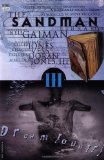
Order The Sandman Vol. 3: Dream Country
from Amazon.com
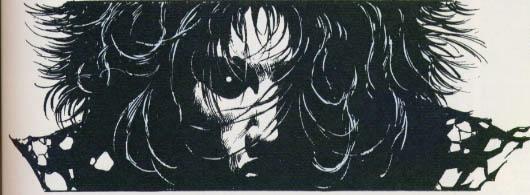

Order The Sandman Vol. 4: Season of Mists
from Amazon.com
This one has a twisty storyline that is hard to describe without spoiling, so I won't try. I will mention, however, that the title character makes only a couple of fairly brief appearances, though his last one is pretty powerful. By now the storyline is making so many references to earlier books that this is probably not a good place to start. This book also features a brief return to King/Barker horror, complete with a man's face cut off and nailed to a wall.

Order The Sandman Vol. 5: A Game of You
from Amazon.com
The latter especially, which came out during the run of A Game of You, is essential for understanding the overall storyline, and a few of the stories are gems (particularly "Ramadan" and the one featuring the Emperor of the United States - a real historical personage). But aside from collecting these disparate stories and placing them together here, they're not even presented in their original order.
A few short months ago, the original version of this page disparaged the "Convergences" stories as "the weakest stories in the saga." I still feel that way (though the series is so fine that its weakest links are still extremely strong), but I take back my original criticism that they were "filler." I once felt that "Convergences" and, to some extent, Brief Lives represented Gaiman trying to stretch the series out to please DC, who had promised to let him end it only to find it suddenly one of their top sellers. I know better now.
I recently saw Neil give a lecture at Washington University in St. Louis, and as I write this I have just completed a rereading of the entire series. The latter tells me that Brief Lives is not padded. Nor is The Kindly Ones, though that book is by far the longest of the series. To the extent that the series became stretched out as it neared its conclusion, the reason was not Gaiman trying to placate his publisher, but a real reluctance to write the ending. He had become fond of Dream, attached to him as a parent to a child. And he didn't want it to end. As he came closer and closer to the inevitable conclusion, it became harder and harder to proceed.
I still think "The Hunt" is a wonderful story that essentially has nothing to do with The Sandman and "The Soft Places" is wholly unnecessary. "The Parliament of Rooks" at least brings Daniel to the Dreaming, and reminds us of his existence, since we haven't seen him since The Dolls House, but it's another of the weaker links, in my opinion. I'm more forgiving now, though, having heard about the anguish Gaiman went through as he realized he actually had to write the ending he'd been heading toward since #1.

Order The Sandman Vol. 6: Fables and Reflections
from Amazon.com

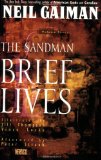
Order The Sandman Vol. 7: Brief Lives
from Amazon.com
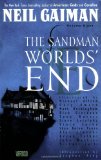
Order The Sandman Vol. 8: Worlds' End
from Amazon.com

Order The Sandman Vol. 9: The Kindly Ones
from Amazon.com
Peter Straub, in the Afterword to Brief Lives, said, "If this isn't literature, nothing is," and his words were echoed by Frank McConnell in his Introduction to The Kindly Ones. I'll go even further. If the complete, collected SANDMAN, from Preludes and Nocturnes through The Wake, is not a literary masterpiece, I don't know what is.

Order The Sandman Vol. 10: The Wake
from Amazon.com


Order Death: The High Cost of Living
from Amazon.com
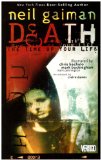
Order Death: The Time of Your Life
from Amazon.com
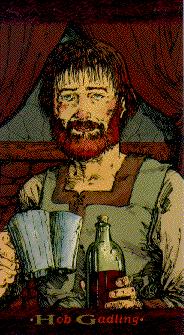
As far as I can tell, it is no longer in print.
 visitors since 09/01/2000
visitors since 09/01/2000
| Steve's Reads (Home) | ||
|---|---|---|
| Cerebus | Sandman | Love and Rockets |
| Interviews | Reviews | Comics & Comic Books |
| Good Comic Books | Good Comic Magazines | Alternative Comics |
If this page looks funny, it may be because I created it with my display set to 800 X 600 pixels, with high (16-bit) color. If you have only 256 colors, my non-standard text color (which should be the same as the "Sandman" logo) and background (which should match the logo background so that you can't see where one ends and the other begins) won't display right, and if you have your screen set at 640 X 480 or 1024 X 768, some of the pictures may not come out quite right with the text. On the other hand, I tried to be as broad-minded as I could be browser-wise. Aside from the tables (which a few primitive browsers won't read), everything on this website is pretty standard. No java or sounds or even animated gifs.
The words on this page and others maintained here are © J. Stephen Bolhafner.
SANDMAN and all the images here are © & ® DC Comics Inc.
Credits for individual images on this page (in order):
(1) Sandman Logo by Dave McKean
(2) Photo of Neil Gaiman from The Magian Line (fan newsletter)
(3) Picture of Dream from "Soft Places" (issue #39) by John Watkiss
(4) Picture of Dream and Death by Mike Dringenberg originally part of a stand-alone display - original piece had text "How would you feel about life if Death were your older sister?"
(5) Dream by Sam Keith and Mike Dringenberg from "Preludes & Nocturnes"
(6) a scene from 'The Sound of Her Wings' (#8) by Mike Dringenberg and Malcolm Jones III
(7) Dream facing Lucifer by Kelley Jones and Malcolm Jones III, from "Season of Mists"
(8) Dream in the rain, by Jill Thompson, and Vince Locke, from "Brief Lives"
(9) Death by Chris Bachalo from postcard promoting "Death: The Time of Your Life"
(10) Hob Gadling in the first scene of "Men of Good Fortune," by Michael Zulli and Steve Parkhouse
Other images in this webspace or pages linked here are all © their respective creators
Feel free to add add this page as a link, or to copy any of the links to your own page -- just don't copy the
words themselves without my express permission, or I shall be forced to send my lawyer over to beat up
your dog.